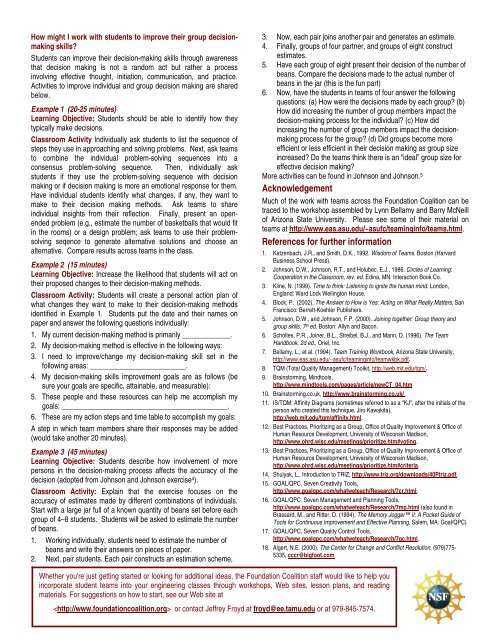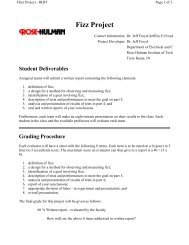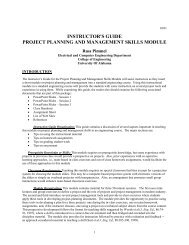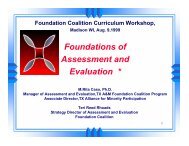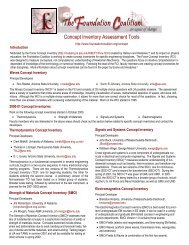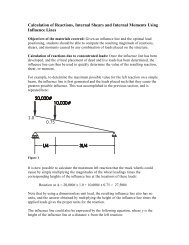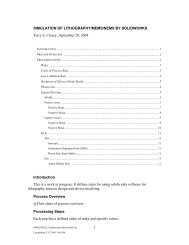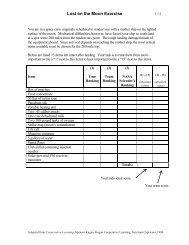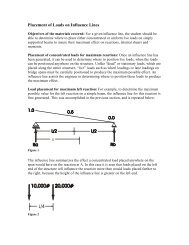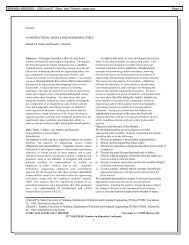Effective Decision Making in Teams - Foundation Coalition
Effective Decision Making in Teams - Foundation Coalition
Effective Decision Making in Teams - Foundation Coalition
Create successful ePaper yourself
Turn your PDF publications into a flip-book with our unique Google optimized e-Paper software.
How might I work with students to improve their group decisionmak<strong>in</strong>gskills?Students can improve their decision-mak<strong>in</strong>g skills through awarenessthat decision mak<strong>in</strong>g is not a random act but rather a process<strong>in</strong>volv<strong>in</strong>g effective thought, <strong>in</strong>itiation, communication, and practice.Activities to improve <strong>in</strong>dividual and group decision mak<strong>in</strong>g are sharedbelow.Example 1 (20-25 m<strong>in</strong>utes)Learn<strong>in</strong>g Objective: Students should be able to identify how theytypically make decisions.Classroom Activity Individually ask students to list the sequence ofsteps they use <strong>in</strong> approach<strong>in</strong>g and solv<strong>in</strong>g problems. Next, ask teamsto comb<strong>in</strong>e the <strong>in</strong>dividual problem-solv<strong>in</strong>g sequences <strong>in</strong>to aconsensus problem-solv<strong>in</strong>g sequence. Then, <strong>in</strong>dividually askstudents if they use the problem-solv<strong>in</strong>g sequence with decisionmak<strong>in</strong>g or if decision mak<strong>in</strong>g is more an emotional response for them.Have <strong>in</strong>dividual students identify what changes, if any, they want tomake to their decision mak<strong>in</strong>g methods. Ask teams to share<strong>in</strong>dividual <strong>in</strong>sights from their reflection. F<strong>in</strong>ally, present an openendedproblem (e.g., estimate the number of basketballs that would fit<strong>in</strong> the rooms) or a design problem; ask teams to use their problemsolv<strong>in</strong>gseqence to generate alternative solutions and choose analternative. Compare results across teams <strong>in</strong> the class.Example 2 (15 m<strong>in</strong>utes)Learn<strong>in</strong>g Objective: Increase the likelihood that students will act ontheir proposed changes to their decision-mak<strong>in</strong>g methods.Classroom Activity: Students will create a personal action plan ofwhat changes they want to make to their decision-mak<strong>in</strong>g methodsidentified <strong>in</strong> Example 1. Students put the date and their names onpaper and answer the follow<strong>in</strong>g questions <strong>in</strong>dividually:1. My current decision-mak<strong>in</strong>g method is primarily _____________.2. My decision-mak<strong>in</strong>g method is effective <strong>in</strong> the follow<strong>in</strong>g ways:3. I need to improve/change my decision-mak<strong>in</strong>g skill set <strong>in</strong> thefollow<strong>in</strong>g areas: __________________________.4. My decision-mak<strong>in</strong>g skills improvement goals are as follows (besure your goals are specific, atta<strong>in</strong>able, and measurable):5. These people and these resources can help me accomplish mygoals: _____________________________________________.6. These are my action steps and time table to accomplish my goals:A step <strong>in</strong> which team members share their responses may be added(would take another 20 m<strong>in</strong>utes).Example 3 (45 m<strong>in</strong>utes)Learn<strong>in</strong>g Objective: Students describe how <strong>in</strong>volvement of morepersons <strong>in</strong> the decision-mak<strong>in</strong>g process affects the accuracy of thedecision (adopted from Johnson and Johnson exercise 4 ).Classroom Activity: Expla<strong>in</strong> that the exercise focuses on theaccuracy of estimates made by different comb<strong>in</strong>ations of <strong>in</strong>dividuals.Start with a large jar full of a known quantity of beans set before eachgroup of 4–8 students. Students will be asked to estimate the numberof beans.1. Work<strong>in</strong>g <strong>in</strong>dividually, students need to estimate the number ofbeans and write their answers on pieces of paper.2. Next, pair students. Each pair constructs an estimation scheme,3. Now, each pair jo<strong>in</strong>s another pair and generates an estimate.4. F<strong>in</strong>ally, groups of four partner, and groups of eight constructestimates.5. Have each group of eight present their decision of the number ofbeans. Compare the decisions made to the actual number ofbeans <strong>in</strong> the jar (this is the fun part)6. Now, have the students <strong>in</strong> teams of four answer the follow<strong>in</strong>gquestions: (a) How were the decisions made by each group? (b)How did <strong>in</strong>creas<strong>in</strong>g the number of group members impact thedecision-mak<strong>in</strong>g process for the <strong>in</strong>dividual? (c) How did<strong>in</strong>creas<strong>in</strong>g the number of group members impact the decisionmak<strong>in</strong>gprocess for the group? (d) Did groups become moreefficient or less efficient <strong>in</strong> their decision mak<strong>in</strong>g as group size<strong>in</strong>creased? Do the teams th<strong>in</strong>k there is an “ideal” group size foreffective decision mak<strong>in</strong>g?More activities can be found <strong>in</strong> Johnson and Johnson. 5AcknowledgementMuch of the work with teams across the <strong>Foundation</strong> <strong>Coalition</strong> can betraced to the workshop assembled by Lynn Bellamy and Barry McNeillof Arizona State University. Please see some of their material onteams at http://www.eas.asu.edu/~asufc/team<strong>in</strong>g<strong>in</strong>fo/teams.html.References for further <strong>in</strong>formation1. Katzenbach, J.R., and Smith, D.K., 1992. Wisdom of <strong>Teams</strong>. Boston (HarvardBus<strong>in</strong>ess School Press).2. Johnson, D.W., Johnson, R.T., and Holubec, E.J., 1986. Circles of Learn<strong>in</strong>g:Cooperation <strong>in</strong> the Classroom, rev. ed. Ed<strong>in</strong>a, MN: Interaction Book Co.3. Kl<strong>in</strong>e, N. (1999). Time to th<strong>in</strong>k: Listen<strong>in</strong>g to ignite the human m<strong>in</strong>d. London,England: Ward Lock Well<strong>in</strong>gton House.4. Block, P. (2002). The Answer to How is Yes: Act<strong>in</strong>g on What Really Matters, SanFrancisco: Berrett-Koehler Publishers.5. Johnson, D.W., and Johnson, F.P. (2000). Jo<strong>in</strong><strong>in</strong>g together: Group theory andgroup skills, 7 th ed. Boston: Allyn and Bacon.6. Scholtes, P.R., Jo<strong>in</strong>er, B.L., Streibel, B.J., and Mann, D. (1996). The TeamHandbook, 2d ed., Oriel, Inc.7. Bellamy, L., et al. (1994). Team Tra<strong>in</strong><strong>in</strong>g Workbook, Arizona State University,http://www.eas.asu.edu/~asufc/team<strong>in</strong>g<strong>in</strong>fo/teamwkbk.pdf.8. TQM (Total Quality Management) Toolkit, http://web.mit.edu/tqm/.9. Bra<strong>in</strong>storm<strong>in</strong>g, M<strong>in</strong>dtools,http://www.m<strong>in</strong>dtools.com/pages/article/newCT_04.htm10. Bra<strong>in</strong>storm<strong>in</strong>g.co.uk, http://www.bra<strong>in</strong>storm<strong>in</strong>g.co.uk/11. IS/TQM: Aff<strong>in</strong>ity Diagrams (sometimes referred to as a "KJ", after the <strong>in</strong>itials of theperson who created this technique, Jiro Kawakita),http://web.mit.edu/tqm/aff<strong>in</strong>ity.html.12. Best Practices, Prioritiz<strong>in</strong>g as a Group, Office of Quality Improvement & Office ofHuman Resource Development, University of Wiscons<strong>in</strong> Madison,http://www.ohrd.wisc.edu/meet<strong>in</strong>gs/prioritize.htm#vot<strong>in</strong>g.13. Best Practices, Prioritiz<strong>in</strong>g as a Group, Office of Quality Improvement & Office ofHuman Resource Development, University of Wiscons<strong>in</strong> Madison,http://www.ohrd.wisc.edu/meet<strong>in</strong>gs/prioritize.htm#criteria.14. Shulyak, L., Introduction to TRIZ, http://www.triz.org/downloads/40Ptriz.pdf.15. GOAL/QPC, Seven Creativity Tools,http://www.goalqpc.com/whatweteach/Research/7cr.html.16. GOAL/QPC, Seven Management and Plann<strong>in</strong>g Tools,http://www.goalqpc.com/whatweteach/Research/7mp.html (also found <strong>in</strong>Brassard, M., and Ritter, D. (1994). The Memory Jogger II: A Pocket Guide ofTools for Cont<strong>in</strong>uous Improvement and <strong>Effective</strong> Plann<strong>in</strong>g, Salem, MA: Goal/QPC)17. GOAL/QPC, Seven Quality Control Tools,http://www.goalqpc.com/whatweteach/Research/7qc.html.18. Algert, N.E. (2000). The Center for Change and Conflict Resolution. (979)775-5335, cccr@bigfoot.com.Whether you're just gett<strong>in</strong>g started or look<strong>in</strong>g for additional ideas, the <strong>Foundation</strong> <strong>Coalition</strong> staff would like to help you<strong>in</strong>corporate student teams <strong>in</strong>to your eng<strong>in</strong>eer<strong>in</strong>g classes through workshops, Web sites, lesson plans, and read<strong>in</strong>gmaterials. For suggestions on how to start, see our Web site at or contact Jeffrey Froyd at froyd@ee.tamu.edu or at 979-845-7574.


